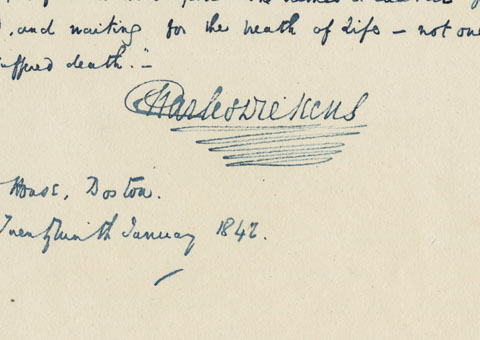Sold – Charles Dickens Writes His Famous Mesmerism Subject, Madame de la Rue, Concerning One of Their Sessions


Dickens humorous prescription for illness: "a mutton chop and a long walk".
Mesmerism was developed by Franz Anton Mesmer, and it used hypnotic trances as a method of healing people. In 1838 Dickens attended several lectures on the subject, including some by John Elliotson. Elliotson was the professor of clinical medicine who introduced the stethoscope to England, and also had campaigned against corrupt medical...
Mesmerism was developed by Franz Anton Mesmer, and it used hypnotic trances as a method of healing people. In 1838 Dickens attended several lectures on the subject, including some by John Elliotson. Elliotson was the professor of clinical medicine who introduced the stethoscope to England, and also had campaigned against corrupt medical practices. Despite his many accomplishments, Elliotson was forced to resign his teaching position in 1839 because of his advocacy of mesmerism, which was quite controversial in the days before hypnotism was accepted. Despite the controversy, Dickens was a believer in mesmerism and he had Elliotson teach him the technique; and it quickly became apparent that Dickens was skilled in this area. Initially he mesmerized family and friends just for fun or to help with minor illnesses, but soon became much more serious about it.
Dickens’s most sustained period of involvement with mesmerism took place during 1845, during the first half of which he was travellng in Italy after the completion of Martin Chuzzlewit. In Genoa, Dickens made the acquaintance of Augusta De La Rue, the English-born wife of Emile, a Swiss banker. Madame De La Rue had suffered for some years from extreme anxiety. It was so profound that it caused noticeable facial tics or spasms, as well as headaches, insomnia, and convulsions. Dickens first mesmerised Madame De La Rue on December 23, 1845, and, finding her a responsive subject, he began to do so regularly, keeping detailed notes of their conversations during her trances. Dickens probed, urged, and insisted, seeming at times the mesmerist and at times the novelist. The treatments were perceived as effective, with Madame de la Rue showing much improvement. She was able to sleep the night and visibly looked more relaxed. Once the physical symptoms of Madame de la Rue eased Dickens became interested in their underlying causes. Their sessions began to focus more on Madame de la Rue's dreams, hallucinations and thoughts; she spoke of being pursued by a "phantom". Their sessions became almost like those of a therapist and a patient, which puts Dickens in a fascinating light seeing as how this was 40 years before Freud started out by using hypnosis and 50 before he began using psychotherapy. Madame de la Rue became the focus of Dickens' trip to Italy, and even as he traveled around the country, he was thoroughly diverted by the updates he regularly received from her in Genoa. Dickens was strongly stimulated by all this, moved by Madame de la Rue herself and her trust in his powers, and excited by the apparently effective exercise of mesmerism. It proved to be an important episode in his life. Mrs. Dickens was less pleased, and although she submitted regularly to her husband’s mesmeric experimentations, she never warmed to his mesmerizing other women, most particularly objecting to Augusta de la Rue.
The Dickens family traveled to Rome and southern Italy during the spring of 1845, then returned to Genoa to prepare to embark for England. Madame de la Rue apparently sought a session with Dickens in May, but he was unable to comply, either because of illness or perhaps because another meeting with her would be impolitic within the Dickens family.
Autograph Letter Signed, Genoa, Italy, Thursday afternoon, May 15, 1845, to Madame de la Rue. "You must not think I am sending you an excuse in lieu of myself. I am in a hideous digestive state, cross, uncomfortable, bilious, blah and limp. A mutton chop and a long walk, and nobody to be contradictory to, are the remedies I have prescribed myself. That stuff in the green reeds is slow murder." This latter statement apparently relates to a patent medicine with which both were familiar. It is also interesting how Dickens describes his prescription for illness: a mutton chop and a long walk. The address panel in Dickens hand and with his signature is still present.
A search of public records for the past 40 years fails to disclose any other letters of Dickens to Madame de la Rue having come up for sale. Dickens returned to England in July 1845.

Frame, Display, Preserve
Each frame is custom constructed, using only proper museum archival materials. This includes:The finest frames, tailored to match the document you have chosen. These can period style, antiqued, gilded, wood, etc. Fabric mats, including silk and satin, as well as museum mat board with hand painted bevels. Attachment of the document to the matting to ensure its protection. This "hinging" is done according to archival standards. Protective "glass," or Tru Vue Optium Acrylic glazing, which is shatter resistant, 99% UV protective, and anti-reflective. You benefit from our decades of experience in designing and creating beautiful, compelling, and protective framed historical documents.
Learn more about our Framing Services









































































































